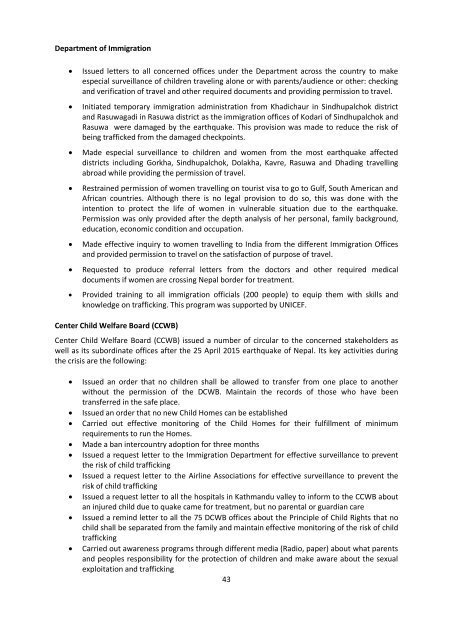TRAFFICKING IN PERSONS
1Spfyta
1Spfyta
Create successful ePaper yourself
Turn your PDF publications into a flip-book with our unique Google optimized e-Paper software.
Under the protection cluster, the following priority actions have been identified:<br />
1. Support a safe and non-discriminatory access to assistance and services such as psychosocial<br />
support and management of sexual violence, official documentation of affected people,<br />
family reunification and ensuring physical security;<br />
2. Strengthen the system for identification, documentation, and support to vulnerable children<br />
and ensure alternative care is provided in a safe way in accordance with the best interest of<br />
the child.<br />
3. Provide girls, boys and women including persons with disabilities in affected areas with safe<br />
spaces such as Child and Women Friendly Spaces as well as life-saving information to all<br />
community members about protecting themselves from violence, abuse and exploitation.<br />
According to the UN estimate a total of US $ 13.71 million is required for protection component. This<br />
accounts for 3.3 percent of the total US $ 422 million budget required for the earthquake affected<br />
populations (www.unocha.org/nepal, see Appendix 3.1).<br />
According to the Gender Equality Bulletin No 1, a total of 17 organizations have been found to be<br />
working under Protection Cluster in the 14 most earthquakes affected districts. UNFPA worked in all<br />
14 districts; WOREC in 13 districts; UN Women in 8 districts; WHR in 8 districts; Saathi, Sankalpa,<br />
Plan Nepal, Oxfam, Jagaran Nepal each worked in six districts; BBC and CARE each worked in 5<br />
districts; FEDO worked in 7 districts and FPAN-ADRA worked in one district. A large numbers of<br />
I/NGOs/UN organizations involvement were in Sindhupalchok (15), Kathmandu (15), Kavre (11),<br />
Lalitapur (9), Gorkha (9) and Nuwakot (8). Few NGOs worked in Rasuwa and Okhaldhunga (Appendix<br />
3.2).<br />
United Nations Children’s Fund (UNICEF) and its Partner Organizations<br />
According to the UNICEF’s Child Protection Earthquake Response (April-May 2015) Bulletin, UNICEF<br />
in collaboration with GoN and NGOs have carried out the following activities to prevent child<br />
trafficking in the 14 most earthquake affected districts of Nepal:<br />
• UNICEF Child Protection has been supporting the Government to develop, strengthen and<br />
implement a comprehensive child protection system.<br />
• After the earthquake, UNICEF supported the MoHA, the Nepal Police and Immigration<br />
authorities to establish and/or strengthen 84 police stations and checkpoints around the<br />
country to prevent and respond to child trafficking. The collaboration between police, CCWB<br />
and UNICEF has led to the interception of 95 children who were attempted to traffic, of<br />
which 25 were attempted to traffic to India.<br />
• UNICEF is supporting the MoWCSW anti-trafficking unit to strengthen anti-trafficking<br />
committees in the 14 most affected districts and 42 border areas. Similarly, UNICEF is<br />
working with the Department of Immigration to ensure that immigration officers receive<br />
effective training to prevent possible cases of trafficking at the border areas.<br />
• UNICEF has entered into partnership with two NGOs working on anti-trafficking. Maiti Nepal<br />
is collaborating with UNICEF to scale up or establish 12 screening and interception points<br />
along the Indian and Chinese borders and create 11 transit centers for victims of trafficking<br />
in as many districts. Shakti Samuha will be supported to conduct surveillance and awareness<br />
raising in the 14 districts.<br />
• To further prevent trafficking, UNICEF has launched an awareness raising and public<br />
information campaign. To date, 40,000 flyers on preventing family separation and trafficking<br />
have been distributed to all 14 districts: 25 flight companies operating in Nepal.<br />
• NICEF is working with 8 municipalities with high incidences of child labor and trafficking to<br />
monitor cases of child labor and child trafficking and strengthen their capacity to prevent<br />
and respond to child labor and trafficking cases.<br />
45


